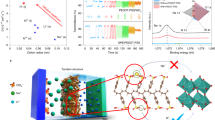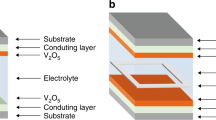Abstract
Bistable electrochromic materials have been explored as a viable alternative to reduce energy consumption in display applications. However, the development of ideal bistable electrochromic displays (especially multicolour displays) remains challenging due to the intrinsic limitations associated with existing electrochromic processes. Here, a bistable electrochromic device with good overall performance—including bistability (>52 h), reversibility (>12,000 cycles), colouration efficiency (≥1,240 cm2 C−1) and transmittance change (70%) with fast switching (≤1.5 s)—was designed and developed based on concerted intramolecular proton-coupled electron transfer. This approach was used to develop black, magenta, yellow and blue displays as well as a multicolour bistable electrochromic shelf label. The design principles derived from this unconventional exploration of concerted intramolecular proton-coupled electron transfer may also be useful in different optoelectronic applications.
This is a preview of subscription content, access via your institution
Access options
Access Nature and 54 other Nature Portfolio journals
Get Nature+, our best-value online-access subscription
$29.99 / 30 days
cancel any time
Subscribe to this journal
Receive 12 print issues and online access
$259.00 per year
only $21.58 per issue
Buy this article
- Purchase on Springer Link
- Instant access to full article PDF
Prices may be subject to local taxes which are calculated during checkout





Similar content being viewed by others
Data availability
The data supporting the findings of this study are available within the article and the Supplementary Information and from the corresponding authors on reasonable request.
References
Kikuchi, H., Yokota, M., Hisakado, Y., Yang, H. & Kajiyama, T. Polymer-stabilized liquid crystal blue phases. Nat. Mater. 1, 64–68 (2002).
Comiskey, B., Albert, J. D., Yoshizawa, H. & Jacobson, J. An electrophoretic ink for all-printed reflective electronic displays. Nature 394, 253–255 (1998).
Chen, Y. et al. Electronic paper: Flexible active-matrix electronic ink display. Nature 423, 136 (2003).
Beaujuge, P. M., Ellinger, S. & Reynolds, J. R. The donor-acceptor approach allows a black-to-transmissive switching polymeric electrochrome. Nat. Mater. 7, 795–799 (2008).
Grätzel, M. Materials science: ultrafast colour displays. Nature 409, 575–576 (2001).
Shi, P. et al. Broadly absorbing black to transmissive switching electrochromic polymers. Adv. Mater. 22, 4949–4953 (2010).
Beaujuge, P. M. & Reynolds, J. R. Color control in π-conjugated organic polymers for use in electrochromic devices. Chem. Rev. 110, 268–320 (2010).
Jensen, J., Hösel, M., Dyer, A. L. & Krebs, F. C. Development and manufacture of polymer-based electrochromic devices. Adv. Funct. Mater. 25, 2073–2090 (2015).
Llordés, A., Garcia, G., Gazquez, J. & Milliron, D. J. Tunable near-infrared and visible-light transmittance in nanocrystal-in-glass composites. Nature 500, 323–326 (2013).
Beaujuge, P. M., Amb, C. M. & Reynolds, J. R. Spectral engineering in π-conjugated polymers with intramolecular donor-acceptor interactions. Acc. Chem. Res. 43, 1396–1407 (2010).
Cai, G. et al. Ultra-large optical modulation of electrochromic porous WO3 film and the local monitoring of redox activity. Chem. Sci. 7, 1373–1382 (2016).
Elool Dov, N. et al. Electrochromic metallo-organic nanoscale films: fabrication, color range, and devices. J. Am. Chem. Soc. 139, 11471–11481 (2017).
Shankar, S., Lahav, M. & Van Der Boom, M. E. Coordination-based molecular assemblies as electrochromic materials: ultra-high switching stability and coloration efficiencies. J. Am. Chem. Soc. 137, 4050–4053 (2015).
Thakur, V. K., Ding, G., Ma, J., Lee, P. S. & Lu, X. Hybrid materials and polymer electrolytes for electrochromic device applications. Adv. Mater. 24, 4071–4096 (2012).
Christiansen, D. T., Tomlinson, A. L. & Reynolds, J. R. New design paradigm for color control in anodically coloring electrochromic molecules. J. Am. Chem. Soc. 141, 3859–3862 (2019).
Hernandez, T. S. et al. Bistable black electrochromic windows based on the reversible metal electrodeposition of Bi and Cu. ACS Energy Lett. 3, 104–111 (2018).
Mortimer, R. J., Dyer, A. L. & Reynolds, J. R. Electrochromic organic and polymeric materials for display applications. Displays 27, 2–18 (2006).
Zhang, S., Cao, S., Zhang, T., Fisher, A. & Lee, J. Y. Al3+ intercalation/de-intercalation-enabled dual-band electrochromic smart windows with a high optical modulation, quick response and long cycle life. Energy Environ. Sci. 11, 2884–2892 (2018).
Shin, H. et al. Energy saving electrochromic windows from bistable low-HOMO level conjugated polymers. Energy Environ. Sci. 9, 117–122 (2016).
Kim, Y. et al. Energy saving electrochromic polymer windows with a highly transparent charge-balancing layer. Adv. Funct. Mater. 27, 1701192 (2017).
Cai, G., Darmawan, P., Cheng, X. & Lee, P. S. Inkjet printed large area multifunctional smart windows. Adv. Energy Mater. 7, 1602598 (2017).
Zhang, Y.-M. et al. A new class of “electro-acid/base”-induced reversible methyl ketone color switches. J. Mater. Chem. C 1, 5309–5314 (2013).
Zhang, Y.-M. et al. Highly durable colour/emission switching of fluorescein in a thin film device using “electro-acid/base” as in situ stimuli. Chem. Commun. 50, 1420–1422 (2014).
Zhang, Y.-M. et al. A single-molecule multicolor electrochromic device generated through medium engineering. Light Sci. Appl. 4, e249 (2015).
Zhang, W. et al. Bio-inspired ultra-high energy efficiency bistable electronic billboard and reader. Nat. Commun. 10, 1559 (2019).
Wang, X. et al. Reversible bond/cation-coupled electron transfer on phenylenediamine-based rhodamine B and its application on electrochromism. ACS Appl. Mater. Interf. 9, 20196–20204 (2017).
Meyer, T. J., Huynh, M. H. V. & Thorp, H. H. The possible role of proton-coupled electron transfer (PCET) in water oxidation by photosystem II. Angew. Chem. Int. Ed. 46, 5284–5304 (2007).
Mora, S. J. et al. Proton-coupled electron transfer in artificial photosynthetic systems. Acc. Chem. Res. 51, 445–453 (2018).
Hammes-Schiffer, S. Theory of proton-coupled electron transfer in energy conversion processes. Acc. Chem. Res. 42, 1881–1889 (2009).
Choi, G. J., Zhu, Q., Miller, D. C., Gu, C. J. & Knowles, R. R. Catalytic alkylation of remote C–H bonds enabled by proton-coupled electron transfer. Nature 539, 268–271 (2016).
Yayla, H. G., Wang, H., Tarantino, K. T., Orbe, H. S. & Knowles, R. R. Catalytic ring-opening of cyclic alcohols enabled by PCET activation of strong O-H bonds. J. Am. Chem. Soc. 138, 10794–10797 (2016).
Costentin, C., Robert, M., Savéant, J.-M. & Tard, C. Inserting a hydrogen-bond relay between proton exchanging sites in proton-coupled electron transfers. Angew. Chem. Int. Ed. 49, 3803–3806 (2010).
Kamiya, N. & Shen, J. R. Crystal structure of oxygen-evolving photosystem II from thermosynechococcus vulcanus at 3.7-Å resolution. Proc. Natl Acad. Sci. 100, 98–103 (2003).
Savéant, J. M. & Tard, C. Proton-coupled electron transfer in azobenzene/hydrazobenzene couples with pendant acid-base functions. hydrogen-bonding and structural effects. J. Am. Chem. Soc. 136, 8907–8910 (2014).
Li, K. et al. Reversible photochromic system based on rhodamine B salicylaldehyde hydrazone metal complex. J. Am. Chem. Soc. 136, 1643–1649 (2014).
Li, G., Mark, M. F., Lv, H., McCamant, D. W. & Eisenberg, R. Rhodamine-platinum diimine dithiolate complex dyads as efficient and robust photosensitizers for light-driven aqueous proton reduction to hydrogen. J. Am. Chem. Soc. 140, 2575–2586 (2018).
Liu, Y. et al. Catalytically active single-chain polymeric nanoparticles: exploring their functions in complex biological media. J. Am. Chem. Soc. 140, 3423–3433 (2018).
Clare, L. A. et al. Electrochemical evidence for intermolecular proton-coupled electron transfer through a hydrogen bond complex in a p-phenylenediamine-based urea. Introduction of the “Wedge Scheme” as a useful means to describe reactions of this type. J. Am. Chem. Soc. 135, 18930–18941 (2013).
Markle, T. F. & Mayer, J. M. Concerted proton–electron transfer in pyridylphenols: the importance of the hydrogen bond. Angew. Chem. Int. Ed. 47, 738–740 (2008).
Bonin, J., Costentin, C., Robert, M., Savéant, J.-M. & Tard, C. Hydrogen-bond relays in concerted proton–electron transfers. Acc. Chem. Res. 45, 372–381 (2012).
Gau, V. et al. Electrochemical molecular analysis without nucleic acid amplification. Methods 37, 73–83 (2005).
Sharp, M., Petersson, M. & Edström, K. A comparison of the charge transfer kinetics between platinum and ferrocene in solution and in the surface attached state. J. Electroanal. Chem. Interf. Electrochem. 109, 271–288 (1980).
Laviron, E. General expression of the linear potential sweep voltammogram in the case of diffusionless electrochemical systems. J. Electroanal. Chem. Interf. Electrochem. 101, 19–28 (1979).
Xi, G. et al. Water assisted biomimetic synergistic process and its application in water-jet rewritable paper. Nat. Commun. 9, 4819 (2018).
Acknowledgements
This study was supported by the National Science Foundation of China (grant nos. 21602075, 21875087) and the programme for JLU Science and Technology Innovative Research Team and Young Elite Scientist Sponsorship Program by Jilin Province of China (181903).
Author information
Authors and Affiliations
Contributions
Y.-M.Z., S.X.-A.Z., Y.W., S.W. and X.W. conceived this project. Y.W., S.W., X.W. and Y.-M.Z. designed the experiments. Y.W., S.W., X.W., W.Zhang and W.Zheng performed the experiments. Y.W., S.W., X.W. and W.Zheng synthesized the materials. Y.W. and X.W. researched the mechanism. Y.W. and W.Zhang fabricated the devices. Y.W., S.W., Y.-M.Z. and S.X.-A.Z. analysed the results. Y.W., Y.-M.Z. and S.X.-A.Z. wrote and revised the manuscript. The project was planned, directed and supervised by S.X.-A.Z. and Y.-M.Z. All authors have given approval to the final version of the manuscript.
Corresponding authors
Ethics declarations
Competing interests
The authors declare no competing interests.
Additional information
Publisher’s note: Springer Nature remains neutral with regard to jurisdictional claims in published maps and institutional affiliations.
Supplementary information
Supplementary Information
Supplementary Figs. 1–49, Tables 1–6, Notes 1 and 2, Methods 1–6, Schemes 1–7, Video Legends 1 and 2 and refs. 1–30.
Supplementary Video 1
Bistable electronic shelf label display.
Supplementary Video 2
Multicolour bistable electronic shelf label display.
Crystallographic Information Files
Crystallographic information for M1, M2 and M3.
Rights and permissions
About this article
Cite this article
Wang, Y., Wang, S., Wang, X. et al. A multicolour bistable electronic shelf label based on intramolecular proton-coupled electron transfer. Nat. Mater. 18, 1335–1342 (2019). https://doi.org/10.1038/s41563-019-0471-8
Received:
Accepted:
Published:
Issue Date:
DOI: https://doi.org/10.1038/s41563-019-0471-8
This article is cited by
-
A fast responsive photochromic SCC-MOF for photoswitching and information encryption
Science China Materials (2024)
-
Complementary multicolor electrochromic devices with excellent stability based on porous tin oxide nanosheet scaffold
Nano Research (2024)
-
Recent progress in Prussian blue electrode for electrochromic devices
Frontiers in Energy (2024)
-
Asymmetric Janus Fibers with Bistable Thermochromic and Efficient Solar–Thermal Properties for Personal Thermal Management
Advanced Fiber Materials (2024)
-
An Electrochromic Nickel Phosphate Film for Large-Area Smart Window with Ultra-Large Optical Modulation
Nano-Micro Letters (2023)



